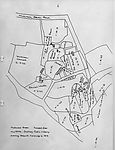Before the industrial revolution, the area we know as the Black Country was made up of hamlets and small towns. Mushroom Green was common land, a piece of land which no-one owns and where people built their own houses. At this time the area was known as "Musham Green".
Lord Dudley was given the land under the Act of Enclosure, so people who were living there had to start paying rent to him. By now the area was known as "Mushroom Bank".
An 1819 map shows that Mushroom Green consisted of sixteen buildings, however there were more than sixteen houses, as some were joined together.
The 1851 Census Returns give us an idea of the age of the hamlet. For example, we find listed one Harriet Pearson, a widow aged 71, her trade listed as "pauper nailer", born Mushroom Green. We also find Thomas Round aged 79, also a "pauper nailer", born Mushroom Green. The cottage rent rolls dated 1720 contain several families named Round, indicating that occupation goes back to at least sometime in the sixteen-hundreds.
At one time, Mushroom Green had three shops, two public houses (the “Fish” and the “Cottage of Content”), a schoolhouse, a police station and a methodist chapel. The Dudley canal was completed in 1779 and ran just half a mile away, and in 1852 the Pensnett railway came right through the centre of the village, so communications with the outside world were excellent.
Rollover the captions in the box to see the available images in thumbnail format, click the caption to see the full-size image
| Reference: | 690 |
| Keywords: | |
| Archive Ref: | |
| Updated: | Mon 11 Jun 2007 - 1 |
| Interpretation written by | Louis Howe |
| Author's organisation | Curatorial |
| Organisation's website |
